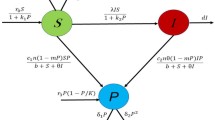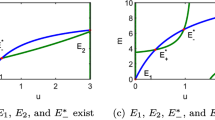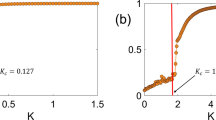Abstract
A discrete-time model of a structured population dynamics considering both density-dependent regulation and natural selection is studied. In the model, the dynamics of two population groups corresponding to different development stages is described, and birth rate limitation is considered. Fertility is assumed to change during microevolution. The stability loss of nontrivial fixed points was shown to realise according to the Neimark–Sacker scenario and the Feigenbaum one. Bifurcations, dynamic modes and possible shifting for the proposed model are explored. Bistability and multistability are also revealed. The phase space structure of bistability and multistability areas in which a variation in population sizes or population genotype compositions can lead to shift in the dynamic modes is examined using attraction basins. The multistability of genetic structure dynamics is also investigated. The presence of multistability fundamentally increases the quantity and variety of possible evolutionary scenarios and makes them dependent on both parameter values and initial conditions. In particular, shifting dynamic mode in a population can occur because of an increase in an individual’s reproductive potential during natural evolution.















Similar content being viewed by others
References
Darwin, C.: On the Origin of Species by MEANS of Natural Selection. Murray, London (1859)
Fisher, R.A.: The Genetical Theory of Natural Selection. Clarendon Press, Oxford (1930) [Variorum edition, Bennett J.H. (ed), 1999, Oxford University Press, Oxford]. https://doi.org/10.5962/bhl.title.27468
Wright, S.: The genetical theory of natural selection: a review. J. Hered. 21, 340–356 (1930)
Haldane, J.B.S.: The Causes of Evolution. Longman Green, London (1932)
Chetverikov, S.S.: About some moments of evolutionary process from the point of view of contemporary genetics. Zhurnal Eksp. Biol. 2, 3–54 (1926). (in Russ.)
Volterra, V.: Variations and fluctuations of the number of individuals in animal species living together. ICES J. Mar. Sci. 3(1), 3–51 (1928)
Gauze, G.F.: Analysis of struggle for survival in mixed populations. Zool. Zhurnal 14(2), 243–270 (1935)
Verhulst, P.F.: Deuxième mémoire sur la loi d’accroissement de la population. Mém. Acad. R. Sci. Lett. Beaux-arts Belgique 20, 1–32 (1847)
Chitty, D.: Mortality among voles (Microtus agrestis) at Lake Vyrnwy, Montgomeryshire in 1936–9. Philos. Trans. R. Soc. Lond. Ser. B Biol. Sci. 236(638), 505–552 (1952). https://doi.org/10.1098/rstb.1952.0009
Chitty, D.: Population processes in the vole and their relevance to general theory. Can. J. Zool. 38, 99–113 (1960). https://doi.org/10.1139/z60-011
Pimentel, D.: Population regulation and genetic feedback. Science 159, 1432–1437 (1968). https://doi.org/10.1126/science.159.3822.1432
Birch, L.C.: Selection in Drosophila pseudoobscura in relation to crowding. Evolution 1955, 389–399 (1955)
Charlesworth, B.: Selection in density-regulated populations. Ecology 52(3), 469–474 (1971)
Gottlieb, L.D.: Genetic stability in a peripheral isolate of Stephanomeria exigua ssp. coronaria that fluctuates in population size. Genetics 76(3), 551–556 (1974)
Gaines, M.S., Leroy, R., McClenaghan Jr., L.R., Rose, R.K.: Temporal patterns of allozymic variation in fluctuating populations of Microtus ochrogaster. Evolution 1978, 723–739 (1978)
Frisman, E.Ya.: Primary Genetic Divergence (Theoretical Analysis and Modeling). Dal’nevost. Nauch. Tsentr Akad. Nauk SSSR, Vladivostok (1986) (in Russ.)
Boonstra, R., Boag, P.T.: A test of the Chitty hypothesis: inheritance of life-history traits in meadow voles Microtus pennsylvanicus. Evolution 41, 929–947 (1987). https://doi.org/10.2307/2409183
Carroll, S.P., Hendry, A.P., Reznick, D.N., Fox, C.W.: Evolution on ecological time-scales. Func. Ecol. 21(3), 387–393 (2007)
Endler, J.A.: Natural selection on color patterns in Poecilia reticulata. Evolution 34(1), 76–91 (1980)
Reznick, D.N., Bryga, H.: Life-history evolution in guppies (Poecilia reticulata): 1. Phenotypic and genetic changes in an introduction experiment. Evolution 41(6), 1370–1385 (1987)
Reznick, D.A., Bryga, H., Endler, J.A.: Experimentally induced life-history evolution in a natural population. Nature 346(6282), 357–359 (1990)
Stearns, S.C.: The genetic basis of differences in life-history traits among six populations of mosquitofish (Gambusia affinis) that shared ancestors in 1905. Evolution 37, 618–627 (1983)
Williams, C.K., Moore, R.J.: Phenotypic adaptation and natural selection in the wild rabbit, Oryctolagus cuniculus, Australia. J. Anim. Ecol. 58, 495–507 (1989)
Sinervo, B., Svensson, E., Comendant, T.: Density cycles and an offspring quantity and quality game driven by natural selection. Nature 406, 985–988 (2000). https://doi.org/10.1038/35023149
Yoshida, T., Jones, L.E., Ellner, S.P., Fussmann, G.F., Hairston, N.G.: Rapid evolution drives ecological dynamics in a predator–prey system. Nature 424, 303–306 (2003). https://doi.org/10.1038/nature01767
Pelletier, F., Garant, D., Hendry, A.P.: Eco-evolutionary dynamics. Philos. Trans. R. Soc. B 364, 1483–1489 (2009). https://doi.org/10.1098/rstb.2009.0027
Mallet, J.: The struggle for existence. How the notion of carrying capacity, K, obscures the links between demography, Darwinian evolution and speciation. Evol. Ecol. Res. 14, 627–665 (2012)
Bertram, J., Masel, J.: Density-dependent selection and the limits of relative fitness. Theor. Popul. Biol. 129, 81–92 (2019)
Waxman, D., Gavrilets, S.: 20 questions on adaptive dynamics. J. Evol. Biol. 18, 1139–1154 (2005). https://doi.org/10.1111/j.1420-9101.2005.00948.x
Fussmann, G.F., Loreau, M., Abrams, P.A.: Eco-evolutionary dynamics of communities and ecosystems. Funct. Ecol. 21(3), 465–477 (2007)
Govaert, L., Fronhofer, E.A., Lion, S., Eizaguirre, C., Bonte, D., Egas, M., Hendry, A.P., Martins, A.D.B., Melian, C.J., Raeymaekers, J.A.M., et al.: Eco-evolutionary feedbacks—theoretical models and perspectives. Funct. Ecol. 33, 13–30 (2019)
Stearns, S.C.: The Evolution of Life Histories. Oxford University Press, Oxford (1992)
Ellner, S.: Environmental fluctuations and the maintenance of genetic diversity in age or stage-structured populations. Bull. Math. Biol. 58(1), 103–127 (1996)
Barton, N., Briggs, D., Eisen, J., Goldstein, D., Patel, N.: Evolution. Cold Spring Harbor Laboratory Press, New York (2007)
Yamamichi, M., Ellner, S.P.: Antagonistic coevolution between quantitative and Mendelian traits. Proc. R. Soc. B Biol. Sci. 283, 20152926 (2016)
Yamamichi, M., Hoso, M.: Roles of maternal effects in maintaining genetic variation: maternal storage effect. Evolution 71(2), 449–457 (2017)
Shapiro, A.P.: To the question about cycles in the recurrent series. Upravlenie i Informaciya 3, 96–118 (1972). (in Russ.)
May, R.M.: Biological populations obeying difference equations: stable points, stable cycles, and chaos. J. Theor. Biol. 51(2), 511–524 (1975)
Syta, A., Litak, G.: Stochastic description of the deterministic Ricker’s population model. Chaos Soliton Fractal 37, 262–268 (2008)
Sacker, R.J., von Bremen, H.F.: A conjecture on the stability of the periodic solutions of Ricker’s equation with periodic parameters. Appl. Math. Comput. 217, 1213–1219 (2010)
Leslie, P.H.: On the use of matrices in certain population mathematics. Biometrika 33(3), 183–212 (1945)
Leslie, P.H.: Some further notes on the use of matrices in population mathematics. Biometrika 35(3/4), 213–245 (1948)
Lefkovitch, L.P.: The study of population growth in organisms grouped by stages. Biometrics 21, 1–18 (1965)
Caswell, H.: Matrix Population Models: Construction, Analysis, and Interpretation, 2nd edn. Sinauer Associates, Sunderland (2001)
Frisman, E.Y.A., Kulakov, M.P., Revutskaya, O.L., Zhdanova, O.L., Neverova, G.P.: The key approaches and review of current researches on dynamics of structured and interacting populations. Comput. Res. Model 11(1), 119–151 (2019). https://doi.org/10.20537/2076-7633-2019-11-1-119-151
Dajor, R.: Precis d’Ecologie. Paris (1972)
Svirezhev, I., Logofet, D.O.: The Stability of Biological Communities. Nauka, Moscow (1978). (in Russ.)
Frisman, E.Y., Skaletskaya, E.I.: Strange attractors in elementary models for dynamics of the quantity of biological populations. Obozrenie Prikladnoy i Promyshlennoy Matematiki 1(6), 988–1008 (1994). (in Russ.)
Frisman, E.Y., Zhdanova, O.L.: Evolutionary transition to complex population dynamic patterns in a two-age population. Russ. J. Genet. 45(9), 1124–1133 (2009)
Frisman, E.Y., Neverova, G.P., Revutskaya, O.L.: Complex dynamics of the population with a simple age structure. Ecol. Model. 222(12), 1943–1950 (2011)
Neverova, G.P., Zhdanova, O.L., Frisman, E.Y.A.: The emergence of complex dynamics during the evolution of a structured limited population. Russ. J. Genet. (2020). https://doi.org/10.31857/s0016675820060065
Kuznetsov, A.P., Sedova, J.V.: Bifurcations of three- and four-dimensional maps: universal properties. Izvestiya VUZ. Appl. Nonlinear Dyn. 20(5), 26–43 (2012). https://doi.org/10.18500/0869-6632-2012-20-5-26-43. (in Russ.)
Kuznetsov, A.P., Savin, A.V., Sedova, Y.V., Tyuryukin, L.V.: Bifurcations of Maps. Publishing Center Science, Saratov (2012). (in Russ.)
Neverova, G.P., Abakumov, A.I., Yarovenko, I.P., Frisman, E.Y.: Mode change in the dynamics of exploited limited population with age structure. Nonlinear Dyn. 94, 827–844 (2018). https://doi.org/10.1007/s11071-018-4396-6
Frisman, E.Y., Neverova, G.P., Kulakov, M.P.: Change of dynamic regimes in the population of species with short life cycles: results of an analytical and numerical study. Ecol. Complex. 27, 2–11 (2016). https://doi.org/10.1016/j.ecocom.2016.02.001
Zhivotovsky, L.A., Gharret, A.J., McGregor, A.J., Glubokovsky, M.K., Feldman, M.W.: Gene differentiation in pacific salmon (Oncorhynchus sp.): facts and models with reference to pink salmon (O. gorbuscha). Can. J. Fish. Aquat. Sci. 51(1), 223–232 (1994)
Gordeeva, N.V., Salmenkova, E.A., Altukhov, Y.P., Makhrov, A.A., Pustovoit, S.P.: Genetic changes in pink salmon Oncorhynchus gorbuscha Walbaum during acclimatization in the White sea basin. Russ. J. Genet. 39(3), 322–332 (2003)
Golovanov, I.S., Marchenko, S.L., Pustovoit, S.P.: Genetic monitoring of northern sea of Okhotsk populations of pink salmon (Oncorhynchus gorbuscha). Cytol. Genet. 43(6), 379 (2009)
Beacham, T.D., McIntosh, B., MacConnachie, C., Spilsted, B., White, B.A.: Population structure of pink salmon (Oncorhynchus gorbuscha) in British Columbia and Washington, determined with microsatellites. Fish. Bull. 110(2), 242–256 (2012)
Sato, S., Urawa, S.: Genetic variation of Japanese pink salmon populations inferred from nucleotide sequence analysis of the mitochondrial DNA control region. Environ. Biol. Fish. 100(10), 1355–1372 (2017)
Carson, H.L.: Increased genetic variance after a population bottleneck. Trends Ecol. Evol. 5(7), 228–230 (1990)
Acknowledgements
This work was partially supported by the Russian Foundation for Basic Research (Nos. 15-18-04-00073a, 18-51-45004 IND_a).
Author information
Authors and Affiliations
Corresponding author
Ethics declarations
Conflict of interest
The authors declare that they have no conflict of interest.
Additional information
Publisher's Note
Springer Nature remains neutral with regard to jurisdictional claims in published maps and institutional affiliations.
Rights and permissions
About this article
Cite this article
Neverova, G.P., Zhdanova, O.L. & Frisman, E.Y. Effects of natural selection by fertility on the evolution of the dynamic modes of population number: bistability and multistability. Nonlinear Dyn 101, 687–709 (2020). https://doi.org/10.1007/s11071-020-05745-w
Received:
Accepted:
Published:
Issue Date:
DOI: https://doi.org/10.1007/s11071-020-05745-w




